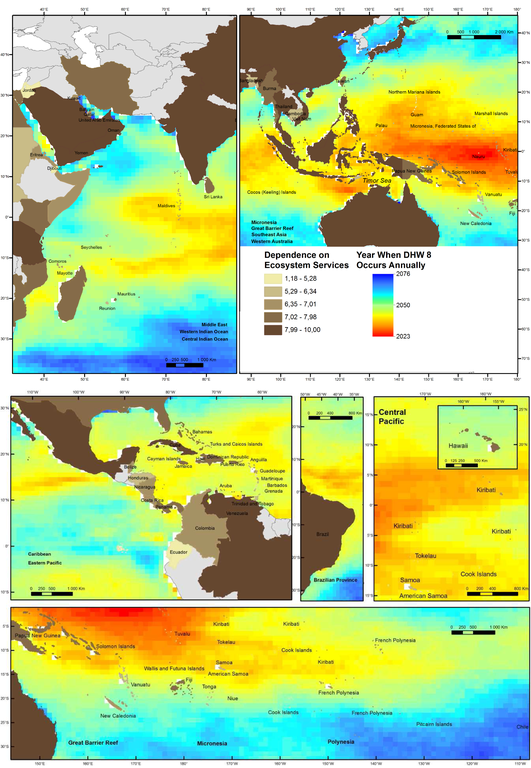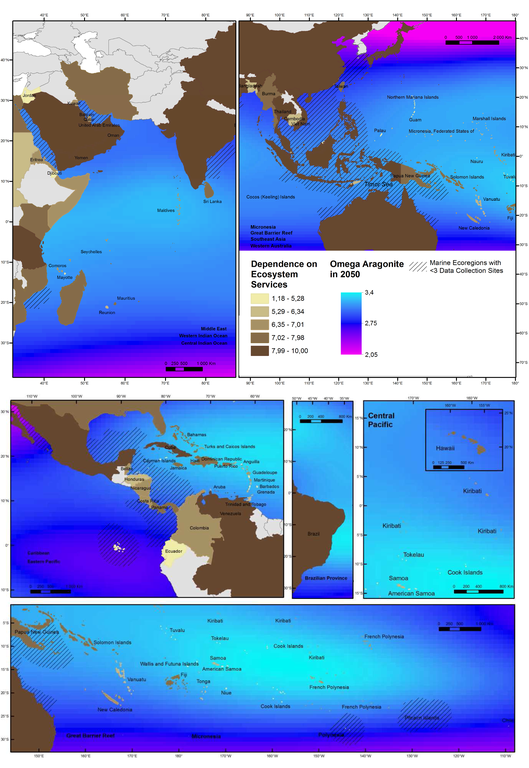CO2-related threats to coral reefs
Countries differ in how much their citizens depend on the ecosystem services provided by coral reefs, but how will coral reefs be impacted by a global environmental change like climate change? If we can identify where coral reefs are most at risk in a high CO2 world, we will be able to know who may suffer the most from the impacts of climate change and ocean acidification on coral reefs and where.
CO2-related threats to coral reefs
A high-CO2 world will lead to two serious stresses for coral reefs: sea surface temperatures rise and the ocean acidification. Higher sea temperatures can cause coral bleaching while ocean acidification can reduce coral growth, reproduction, and in the extreme may cause corals to dissolve. Separately, climate change and ocean acidification can lead to reef decline and death, but together the combined effects can be even worse.
Using Degree Heating Week (DHW) to determine the risk of bleaching
Prolonged thermal stress can cause mass coral bleaching. Degree Heating Week (DHW) is "a cumulative measurement of the intensity and duration of thermal stress, and is expressed in the unit °C-weeks" (Source: Coral Reef Watch by NOAA). In other words, DHW is a proxy for coral bleaching. Coral bleaching is significant when DHW values reach 4°C-weeks. Coral mortality and widespread bleaching can be expected when DHW reaches 8°C-week.
To understand where the stress of a heating ocean may be most severe for corals, we use predictions from the Intergovernmental Panel on Climate Change (IPCC) RCP8.5 scenario - that is to say the scenario leading to severe climate change - in order to envision sea surface temperatures in a high-CO2 world. Using this scenario, we mapped the year when DHW is predicted to reach 8°C-week, a level known to be lethal to corals. The results are presented in the figure below (Fig. 1): the redder the map, the sooner the risk of coral bleaching.

Fig 1. Country-level dependence on coral reef ecosystem services and future risk of coral bleaching.
Bleaching risk is indicated by the year when DHW8 is first reached annually, under RCP8.5 scenario. Ocean Provinces are indicated in each panel in bold. Earlier years indicate increased bleaching risk.
Omega aragonite levels as a proxy of ocean acidification stress
In order to depict the risks associated with ocean acidification, we follow other scientists and use information about saturation state of carbon in sea water, or Omega aragonite levels. Since there is no agreed upon threshold at which corals die, we worked with our colleagues at NOAA to map omega aragonite levels predicted to occur 2050 (for more information, see what is omega aragonite level?). Lower aragonite levels (represented by pinker areas in Figure 2) indicate higher risks due to ocean acidification.
Fig 2. Country-level dependence on coral reef ecosystem services and future risk of ocean acidification as omega aragonite level in 2050 (based on GLODAP, CARINA and PACIFICA data). Ocean Provinces present in each panel in bold. Lower omega aragonite levels reflect higher ocean acidification risk.

